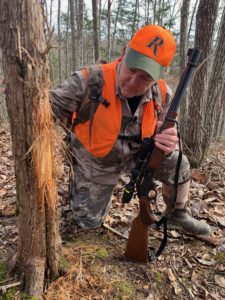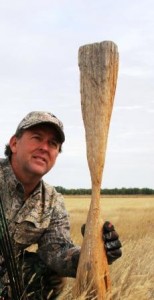 Bucks start rubbing saplings and trees in September up to about October 20, and then a second major phase of rut rubbing kicks in. With testosterone pumping in their veins now, the bucks go to work, thrashing and gouging trees (and sometimes fence poles) to vent pent-up sexual energy. The act of rubbing thickens the muscles in a buck’s neck, and helps him to put his game face on. If he’s challenged by a rival in the coming weeks, he’ll be ready. Some scientists say these rut rubs also stimulate the does and help to synchronize breeding cycles.
Bucks start rubbing saplings and trees in September up to about October 20, and then a second major phase of rut rubbing kicks in. With testosterone pumping in their veins now, the bucks go to work, thrashing and gouging trees (and sometimes fence poles) to vent pent-up sexual energy. The act of rubbing thickens the muscles in a buck’s neck, and helps him to put his game face on. If he’s challenged by a rival in the coming weeks, he’ll be ready. Some scientists say these rut rubs also stimulate the does and help to synchronize breeding cycles.
With the rut coming on all testosterone-addled bucks large and small join in the rubbing fun. But again, look for good-sized rubs as thick as your bicep. All hopped-up bucks rub small to tiny saplings in the rut, but only the older bucks with larger racks regularly work trees 6 to 9 inches or more inches in diameter.
The number of rubs that pop up in your woods can give you an idea of how many shooter bucks are working the area this season. Put simply, the more rubs, the more older-age bucks. “On one of our projects, we started out seeing about 700 rubs per square mile, or about 1 per acre,” says deer scientist Dr. Grant Woods. “After five years of management, as we increased the number of mature bucks in the herd, it had increased to 5,000 rubs per square mile, or 7.8 per acre. The size of the rubbed trees also increased significantly.”
Speaking of size, a shredded cedar or hardwood 7 to 10 inches to maybe even a foot in diameter is a dandy rub. (A 12-inch-diameter rub is the biggest I’ve ever found, but they come larger.) Every biologist says the same thing, something to this effect: “Only a prime-age, top-end buck will tackle a tree like that and open a blaze on it. Other bucks will come along and smell it or even rub and lick it, but the sign-post is the mark of an exceptional buck.”
Best Rubs to Hunt
Early rubs in September and October mark some segment of a buck’s core area, so use them as a marker. But don’t just throw up a stand and hope you see him. Scout out from the rubs and check deeper in the woods and along the edges, looking for trails, creek crossings, any funnel with fresh deer tracks. Hang a stand or two (and a trail cam) in the best bottlenecks you find. There’s a decent chance you’ll see the rub-maker.
In a good mast year, you’ll find dozens to maybe even hundreds of rubs on a ridge or in a woodlot thick with white oaks and some reds. Play the wind and terrain as described earlier, and set up on a trail or in a funnel within 100 yards of those rubs.
 In a Tennessee study, researchers found 2 specific terrains where bucks love to rub. The first is a “valley,” or a draw, ditch, swale and the like with brushy cover. Also look for “secondary points,” or humps or flats that run out and drop off the sides of ridges. The researchers said bucks use the points as ramps for easy access from the valleys up to ridges, rubbing as they come and go.
In a Tennessee study, researchers found 2 specific terrains where bucks love to rub. The first is a “valley,” or a draw, ditch, swale and the like with brushy cover. Also look for “secondary points,” or humps or flats that run out and drop off the sides of ridges. The researchers said bucks use the points as ramps for easy access from the valleys up to ridges, rubbing as they come and go.
Personally, I’ve found that big deer love to troll and rub in 3 spots: side-hills with cover (similar to the secondary points); in brushy, overgrown logging roads; and along edges where the habitat changes (pines meet deciduous forest, second-growth runs into a brushy field, etc.). These are great spots to find rubs and hang stands.
Keep an eye out for a cluster of 3-inch-wide or larger rubs in a hidden thicket on a ridge or in a bottom. Most likely the rubs mark a spot where a good buck has been bedding. A stand downwind of that cover is a good option for a morning ambush.
One year I stayed out of one of my favorite spots until November 12. I went in and found the ridge ripped with sign and reeking of tarsal, as I knew I would. Whitetails are habitual. If the habitat stays the same, and if you don’t pressure a spot too early, generations of bucks will blaze rubs and dig scrapes in the same areas year after year.
Sign was aplenty, but it took awhile to find what I was looking for—three freshly shredded, thick rubs at the point where two muddy trails converged into one and funneled out the brush to a cornfield 150 yards away. I’ve been hunting whitetails for 30 years. There aren’t many spots I’d rather hunt in the rut than a “rub junction” like that.
The wind would be out of the northwest in the morning, so I hung my stand south of the junction and crept out of there. Next day, the third buck I saw was a 4 ½-year-old 10-pointer. My muzzleloader shot was on, and he crashed down within 80 yards of those big rubs.
Read ‘em right and you can score like that.





